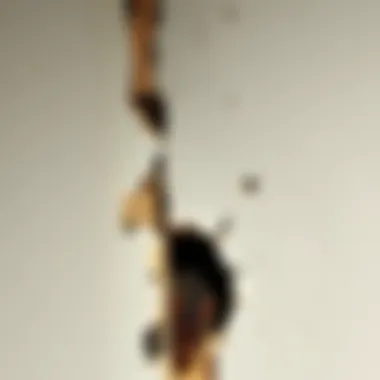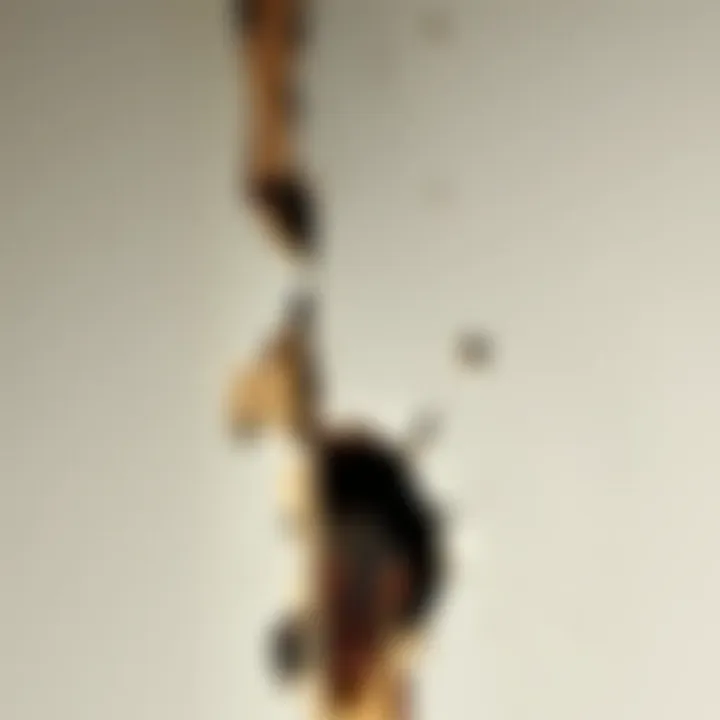Effective Home Remedies for Mouse Prevention


Intro
The battle against mouse infestations is one that many homeowners face, often with a sense of dread. These little critters, while seemingly harmless, can cause quite a mess. They nibble on food, chew through wires, and may even carry diseases. For housewives and homeowners alike, keeping these unwelcome guests at bay is a top priority. This article explores effective home remedies that can be embraced to prevent mouse invasions, laying out practical strategies that anyone can follow. Think of it as arming yourself with knowledge to ward off these pests before they make themselves at home among your prized belongings.
Pest Identification
Common Household Pests
Mice are not the only pests people deal with, but they are among the most common. From Norway rats to house mice, knowing what you are up against is half the battle. Here’s a peek at the type of pests that might intrude your cozy abode:
- House Mouse: Small, with a pointed snout and large ears. They often seek warmth.
- Norway Rat: Thicker and larger, these rats love to burrow. They are often found in attics or underneath sinks.
- Field Mouse: More prevalent outdoors, they can also infiltrate homes in search of food.
Each type has its unique behaviors and habitats, making identification crucial.
Signs of Infestation
So, how do you know if you have uninvited guests? Keep your eyes peeled for these clues:
- Droppings: Look for small, dark pellets near food sources or nesting sites.
- Gnaw Marks: Look around wooden surfaces or food packaging; fresh gnaw marks indicate recent activity.
- Nests: Often made from shredded materials, nests can be found in hidden corners, attics, or basements.
"An ounce of prevention is worth a pound of cure." Identifying the signs early can save you a whole lot of trouble later.
Prevention Methods
Environmental Modifications
To kickstart your mouse prevention efforts, consider a few environmental modifications. Adjust the landscape and household setup:
- Close Entry Points: Inspect walls, windows, and doors for cracks and holes. A mouse can squeeze through a gap as small as a dime! Seal these openings with steel wool or caulk.
- Declutter: Keep your home tidy. Mice prefer clutter as it provides hiding spots. Organize storage areas and keep food in secure containers.
Home Maintenance Tips
A well-maintained house is less appealing to rodents. Here are some maintenance tips to keep in mind:
- Regularly Inspect Pipes and Ducts: Ensure they are sealed properly. Mice can find these pathways easy to navigate.
- Check for Leaks: Water sources can attract mice. Fix any plumbing issues promptly.
DIY Pest Control Solutions
Natural Remedies
When it comes to repelling mice, nature often provides some vital solutions. Here’s a few that may help:
- Peppermint Oil: The strong scent repels mice. Soak cotton balls in peppermint oil and place them in nooks and crannies.
- Vinegar: Mix equal parts of water and vinegar in a spray bottle. Spraying this around entry points can deter mice due to its strong odor.
- Ultrasonic Devices: These emit high-frequency sounds that are unpleasant for rodents but cannot be heard by humans.
DIY Traps and Barriers
If you prefer a more hands-on approach, why not try your hand at some traps? Here are some DIY ideas:
- Bucket Trap: Fill a bucket with water and place a ramp going up to it. The mouse tries to climb up and falls in.
- Cardboard Traps: Cut a hole in a cardboard box and place food just inside. The mouse will crawl in, and you can dispose of it responsibly.
By using these strategies, you can create an environment that actively discourages mice from settling in. Every step taken is a step toward a mouse-free home.
Preamble to Mouse Infestations
Dealing with mouse infestations is no walk in the park. These small rodents can wreak havoc in a home, nibbling away not just on food but also at the fabric of your sanity. Understanding the importance of tackling this issue right off the bat can help homeowners prevent the larger consequences that come with a full-blown infestation.
When you notice a mouse scurrying across the kitchen floor, it’s often just the tip of the iceberg. Mice breed quickly and can produce up to ten litters in a year, with each litter bearing multiple pups. Left unchecked, what starts as a single mouse can escalate into a household of rodents in no time. This becomes not just a nuisance, but a potential health risk, as mice carry various diseases like hantavirus and salmonella.
The stakes are high, especially for those who enjoy the comforts of their home.
A key aspect of this article is to empower homeowners with practical knowledge. By applying effective home remedies and preventive measures, you can evict these unwanted guests before they set up camp. Focusing on natural methods not only contributes to keeping the family safe but is also a healthier choice for the environment. After all, no one wants to deal with the lingering smell of chemical traps or sprays.
Additionally, this topic is vital for fostering a proactive mindset. It encourages individuals to recognize identifying signs of a mouse problem early on. Knowing what to look for could mean the difference between an easy fix and a long-term battle against an infestation.
Moreover, learning about mouse behavior truly underpins effective prevention strategies. By grasping their habits and preferences, you can tailor your home environment accordingly. For instance, realizing that mice often seek shelter near food sources or cozy nests can guide you on how to keep those areas less inviting.
In summary, understanding mouse infestations is not merely an academic exercise; it's a crucial life skill for anyone wanting to protect their home and their peace of mind. By diving into this article, homeowners will gain the insights needed to turn their living spaces into mouse-resistant sanctuaries.
Understanding Mouse Behavior
Understanding mouse behavior is essential for anyone looking to prevent infestations in their homes. When you grasp how mice think and act, you can tailor your strategies for keeping them at bay. Mice are not just nuisances; they are creatures with deep-rooted instincts, shaped by their environment and survival needs. This understanding can lead to more effective, sustainable solutions in pest control, lessening reliance on chemicals that might do more harm than good.
Habitat Preferences
Mice are attracted to environments that provide shelter, warmth, and access to food. Knowing where these critters prefer to settle can guide your prevention tactics. They tend to favor hidden spots like attics, basements, and even behind appliances. It’s particularly vital to note that they also prefer areas that provide easy access to nesting materials.
For instance, clutter, like stacks of papers or old clothes, can make a perfect home. Thus, regular decluttering and a thorough clean-up routine can significantly diminish their chances of finding a cozy nook in your abode. Moreover, all households should consider sealing off potential entry points; even the smallest cracks or gaps could provide an invitation for uninvited guests.
"Sealing your home tight is not just about keeping warmth in. It’s about a proactive defense against these crafty little invaders."
Feeding Habits
Feeding habits play a significant role in mouse behavior and their presence in your home. Mice are opportunistic eaters, which means that they will nibble on almost anything they can find. Their diet primarily consists of grains, fruits, and seeds. However, they’re not too picky and will happily munch on leftover human food, which makes proper food storage essential.


Important considerations include storing food in airtight containers, cleaning up spills promptly, and not leaving pet food out overnight. Mice have incredible senses, which allow them to locate food from a long distance. Therefore, even a small crumb can grab their attention and entice them to move in. By ensuring that food sources are scarce, you build a solid line of defense against these pests.
Signs of Infestation
Recognizing the early signs of a mouse infestation can mean the difference between a small issue and a full-blown invasion. When a mouse makes itself at home, it can multiply rapidly, causing damage and potential health risks. Therefore, vigilance is key. Homeowners should be educated about the physical signs that indicate their space might be harboring unwanted guests. This understanding empowers them to take action before it becomes a major concern. By familiarizing yourself with various signs, you can address problems promptly, defend your home, and even save on costly extermination services down the line.
Sightings and Droppings
The most evident indication of a mouse presence is the actual sighting of the critters themselves. If you spot a mouse darting around during the day, it’s safe to presume that's a sign your home is attracting these pests. Mice are generally nocturnal, so daytime appearances might suggest an established infestation. However, they usually stay hidden, preferring to scurry around when it's dark and quiet.
Aside from sightings, mouse droppings are another critical telltale sign. These tiny, dark pellets can be found near food sources, trapping areas, or anywhere they travel frequently. You’ll often see droppings behind appliances, in kitchen drawers, or on shelves. Notably, mouse droppings can be approximately the size of a grain of rice, often resembling elongated pellets. Finding them in clusters is a clear red flag. For instance, if you notice droppings in your pantry where you store food, action should be taken immediately.
"The first rule of thumb in pest control is that when you spot one, there's likely a lot more lurking behind the scenes."
Nests and Gnaw Marks
Another major indication of a mouse infestation is the discovery of their nests and gnaw marks. Mice create nests to make a comfortable space for their young; these nests are often made from shredded paper, fabric, or even insulation material. They tend to build nests close to food supplies or shelter areas, such as in attics or inside walls. If you're moving items around in your attic or garage and come across a cluttered pile of shredded materials, pay attention. This could signify that the mice have made your storage space their abode.
Furthermore, you should inspect for gnaw marks. Mice have very strong, ever-growing teeth, and they must gnaw on items to keep them trimmed. Check wooden furniture, door frames, or even wires. Gnaw marks look like fresh, uneven scratches; they often have a smooth surface where the wood grain has been chewed away. If you see these signs, it indicates an established nest nearby, and it may be time to strategize your mouse prevention methods.
Staying alert to these signs is essential. Understanding how to detect an infestation not only helps in eradicating the issue quicker but also prevents the potential for future problems.
Key Principles of Prevention
Preventing mouse infestations is one of the most prudent steps a homeowner can take. Key principles of mouse prevention come down to two main approaches: exclusion techniques and sanitation measures. Each method plays a significant role and when effectively employed, they combine to create a less inviting environment for these uninvited guests. It’s crucial not just to react when a problem arises, but to actively take steps that deter mice from ever setting foot in your home.
By focusing on these principles, homeowners can minimize the risk of rodent problems while enhancing the overall comfort of their living spaces. The benefits are twofold; not only are you actively preventing potential infestations, but also improving hygiene and reducing health risks associated with mice.
Exclusion Techniques
Exclusion techniques involve physically blocking mice from accessing your home. These steps are not only about keeping your space clean but also about creating a barrier that no rodent can breach. To start, conduct a thorough inspection of your property. Look for any cracks or openings, particularly around the foundation, windows, pipes, and vents. It's all about creating a fortress.
- Seal Cracks and Gaps: Use caulk or steel wool to fill any gaps you find. Mice can squeeze through holes as small as a dime! Thoroughly sealing these entry points acts as the first line of defense.
- Install Door Sweeps: Ensure that all exterior doors have tight-fitting sweeps. This is an often-overlooked area where mice can slip in. A good door sweep can reduce this risk significantly.
These methods, while simple, require a keen eye and a bit of elbow grease. Regular maintenance checks are essential; remember, an ounce of prevention beats a pound of cure.
Sanitation Measures
Sanitation measures focus on removing the attractions that draw mice into your home. By minimizing food sources and shelter within your residence, you're making it less appealing for them to move in.
- Proper Food Storage: Store food in airtight containers to keep the aroma sealed. Invest in glass or hard plastic containers for pantry items like flour, cereal, and pet food. Mice have an excellent sense of smell, and if they catch a whiff of something tasty, they're bound to investigate.
- Regular Cleaning: Maintain a clean household by frequently sweeping and vacuuming. Mice leave droppings and urine that can be hazardous to health, making cleanliness key in prevention strategies.
Keeping a clutter-free environment denies mice both food and nesting materials. The less they find, the less likely they are to invite themselves in.
By implementing these exclusion techniques and sanitation practices, homeowners can significantly reduce their chances of facing a mouse infestation. In the game of prevention, a proactive approach is always the best defense. Connect to resources like CDC and EPA for additional guidelines on pest control and health implications.
Natural Deterrents
Natural deterrents play a crucial role in preventing mouse infestations in homes. By using elements that are derived from nature, homeowners can create an inhospitable environment for rodents without resorting to harsh chemicals. These remedies are often more safe for families and pets, making them an appealing option for many. As the saying goes, "an ounce of prevention is worth a pound of cure." Incorporating natural deterrents can significantly reduce the chances of a mouse problem in the first place.
Essential Oils
Peppermint Oil
Peppermint oil stands out as one of the most favored natural deterrents against mice. Its strong aroma is not just refreshing but also signals an unpleasant environment for rodents. One of the unique characteristics of peppermint oil is its powerful menthol content, which creates a cooling sensation, effectively repelling these pesky critters. Homeowners have found success by soaking cotton balls in peppermint oil and placing them in areas where mice tend to enter or nest.
However, while peppermint oil is effective, there are some considerations. Its scent dissipates relatively quickly, meaning that it needs to be reapplied frequently for continued performance. Yet, its natural properties make it appealing, as it doesn't pose any chemical hazard to household members.
Clove Oil
Clove oil is another superb option when it comes to deterring mice. This oil has a warm, strong smell that mice avoid like the plague. The key characteristic of clove oil is its high eugenol content, providing an aromatic effect that adds both flavor to food in kitchens and a barrier for uninvited guests. When used effectively, clove oil can create an environment that discourages rodent presence.
On the flip side, clove oil can be potent and may irritate sensitive individuals if used excessively. Thus, moderation is crucial. A few drops on cotton balls placed strategically can work wonders without overwhelming other scents in your environment.
Herbs and Spices
Bay Leaves
Bay leaves are not just for culinary delights; they can be an effective natural deterrent against mice, too. The distinctive smell of fresh bay leaves is said to be unappealing to rodents. Homeowners often find success by placing dried bay leaves in cupboards and pantry areas. The unique feature of bay leaves is that they stay dry and do not decompose quickly, allowing for long-lasting effects.
Nonetheless, it's worth noting that the effectiveness can vary, and they should be combined with other methods for best results. Using bay leaves complements a more comprehensive mouse prevention strategy.
Cayenne Pepper
Cayenne pepper adds more than just spice to meals; it can also spice things up in the fight against mice. This fiery pepper contains capsaicin, which is the element responsible for its heat. When sprinkled in mouse-prone areas, its intensity acts as a deterrent. A sprinkle here and there can ensure that these critters think twice before making a home in your space.
However, like bay leaves, cayenne pepper may not be a standalone solution. It can be effective but often needs to be reapplied after cleaning or moisture. Be mindful of where you place it, as its strength might cause discomfort to pets or children.
Physical Barriers
In the quest to keep mice out of our homes, employing physical barriers can be downright essential. These are not just simple measures; they form the first line of defense against potential infestations. The sheer idea is to make it physically challenging for these tiny creatures to enter our living spaces. After all, if they can’t get in, they can't make a meal of your pantry's contents or settle in behind the walls.
The benefits of physical barriers are multifaceted. For one, they offer a long-term solution as opposed to short-lived fixes. Once you effectively seal the entry points, you reduce the chances of any future visitors considerably. Furthermore, creating a physical blockade gives homeowners peace of mind. You won’t have to constantly be on the lookout for tell-tale signs of mice, and this stability can lead to a more relaxed home environment.
However, some considerations are vital to keep in mind. Not every entry point is obvious, nor does every home have identical vulnerabilities. Therefore, understanding the typical access points through which mice can enter is key. Factors such as the house's architecture, location, and even the weather can influence these entry points. But with a keen eye and some diligence, you can fortify your home against any unexpected guests.


Sealing Entry Points
The first step in fortifying your home should be to meticulously seal any potential entry points. Think of your house as a fortress; if there are cracks or gaps, they become gateways for unwanted visitors. Mice are notoriously crafty and can fit through openings as small as a dime. Common spots that often go overlooked include:
- Gaps around pipes and wires in exterior walls
- Cracks in foundations or walls
- Spaces beneath doors and windows
- Vents and vents covers that may be loosely fitted
To seal these entry points effectively, consider using a combination of materials. Caulk works wonders for small cracks and gaps, while steel wool can block larger openings. Mice don’t like gnawing through tough materials, so integrating metal mesh or hardware cloth can add that extra layer of protection. Ensure that every potential access point is addressed to significantly reduce the risk of infestation.
Use of Screens and Mesh
When it comes to keeping mice at bay, screens and mesh serve as an excellent supplementary measure. Imagine a fine net that no mouse could dare to traverse. Installing wire mesh over vents or gaps not only allows ventilation but also acts as an impenetrable barrier. For instance, using 1/4-inch hardware cloth on vents is particularly effective, as mice are simply unable to gnaw through such a strong material. Also, applying screens to windows is a good idea, especially if you like to open them during warmer months.
Aside from basic prevention, screens and mesh can bring additional benefits. They can provide filtration against insects, contributing to a healthier indoor environment. Investing in durable materials ensures that you won’t have to constantly replace damaged screens or mesh due to wear and tear.
Traps and Baits
In the realm of mouse prevention, the strategic use of traps and baits plays a pivotal role in addressing and managing these unwelcome guests. While one might think of traps as an outdated measure, they are a vital component in an effective home defense against mice. By employing both humane traps and DIY bait stations, homeowners can not only reduce mouse populations but also foster an environment of proactive pest management.
Using traps can significantly limit infestation levels when seasonal changes push mice into our homes seeking warmth and food. It’s a method that requires attention to detail and consistent monitoring to ensure lasting effectiveness. Here, we will explore two primary aspects of this topic: humane traps and DIY bait stations.
Humane Traps
Humane traps represent a kind-hearted alternative to traditional methods of pest control. These traps work by luring the mouse in with bait and containing it without causing harm. Once captured, homeowners have the option to release the rodents away from their property, allowing them a chance to roam freely elsewhere.
One of the primary benefits of humane traps is that they align with a growing sentiment towards compassionate treatment of animals. Many individuals prefer this method not only for ethical reasons but also out of a desire to avoid dealing with the mess that comes with conventional traps.
Some critical considerations when using humane traps include:
- Strategic Placement: Positioning these traps in areas where mice are frequently seen, such as near droppings or gnawed items, increases the likelihood of success.
- Bait Choice: Using attractive baits like peanut butter, sunflower seeds, or even bits of fruit can draw in curious mice.
- Regular Checks: It's essential to check traps regularly to ensure that captured mice are not left in confinement for extended periods.
- Release Protocol: Familiarize yourself with local regulations regarding the release of captured rodents to ensure compliance with wildlife guidelines.
DIY Bait Stations
DIY bait stations are an ingenious way to tackle the issue of mouse infestations while providing flexibility and cost-effectiveness. Essentially, these stations are homemade devices that deliver bait — often a combination of food and substances that deter rodents from returning.
Creating a bait station can be as simple as using a sturdy plastic container with small holes that allow mice to enter but keep out larger pests. You can fill the container with enticing bait to lure them in, making it a practical solution for long-term management.
A few points to keep in mind when constructing DIY bait stations include:
- Materials: Use a weather-resistant container if you're placing the station outdoors. This prolongs its efficacy.
- Bait Safety: Avoid toxic substances, especially if you have pets or children around. Safe alternatives include oats mixed with a bit of coconut oil, or even pet food.
- Location, Location: Just like with humane traps, place bait stations where signs of mice are abundant — think pantry corners or behind appliances.
- Surveillance: Regularly check the bait stations to replenish bait and observe any signs of activity to adapt your strategy as needed.
A proactive approach to mouse control involves not just the installation of traps and bait stations but also ongoing monitoring to adapt to their elusive nature.
Environmental Modifications
Creating a mouse-resistant environment is a cornerstone of pest management. While traps and baits might provide immediate relief, long-term solutions rely heavily on environmental modifications. These tweaks not only deter mice but also foster a healthy, clean living space. By strategically altering the way your surroundings are maintained and organized, you can shift the odds in your favor, making your home less inviting for unwanted guests.
The essence of environmental modifications lies in understanding that mice are adaptable creatures with specific preferences. They’re not just searching for food; they’re on the lookout for shelter and safety. Here, we will delve into two main aspects: landscaping strategies and storage solutions, both crucial in enhancing your defense against these nimble invaders.
Landscaping Strategies
When it comes to landscaping, a little planning goes a long way. Mice enjoy areas that provide cover and nest-building materials, so consider approaching your garden with a sense of prevention. For example:
- Shorten Overgrown Vegetation: Tall grass and dense shrubbery can be potential havens for mice. Keeping your garden trimmed and tidy dissuades them from making a home in your yard.
- Choose Plants Wisely: Some landscaping plants attract mice. Steering clear of certain flowering plants, which tend to harbor more pests, can be advantageous. Instead, incorporate hardier plants that don’t offer as many hiding places.
- Create a Barrier: Planting some prickly plants or thorny bushes just around the outer boundaries can act as natural barriers. Mice prefer easy access to food and shelter; anything that complicates their approach might just render your property less desirable.
- Regular Yard Maintenance: Keeping piles of leaves or wood can provide shelter for mice. Regularly remove such items from your yard to eliminate potential nesting spots.
Utilizing these landscaping strategies not only beautifies your outdoor space but also creates an unwelcoming environment for rodents.
Storage Solutions
An organized home is not just visually appealing; it’s essential when preventing mouse infestations. Mice have an uncanny knack for finding an opening or reaching food, so thoughtful storage practices become vital:
- Seal Food Items: Secure all food items in airtight containers. Even minor spills attract mice. Using containers made of glass or thick plastic can also deter them from chewing through to accessible snacks.
- Utilize Clear Bins: Transparent storage bins allow you to see what’s inside without opening them, which reduces the frequency of air-polluting chances.
- Label Everything: Clearly labeled boxes and bins ensure you’re aware of your stored goods, further aiding in organization and maintenance. You’ll find that finding things is easier too!
- Store Junk Away: Items that are rarely used should be stored off the floor and in less accessible areas. Keeping clutter minimal not only helps in keeping rodents at bay but also streamlines your space and improves overall tidiness.
By implementing these storage solutions, you’re sending a clear message to any mice scoping out your space: there’s no food; there’s no shelter—better keep moving.
"A clean home is a mouse-free home. It’s not just a saying; it’s a motto that serves you well in keeping the critters away."
Behavioral Changes for Prevention
Preventing mouse infestations hinges significantly on the behavioral changes we implement in our daily lives. This aspect is often overlooked, yet it plays a crucial role in curbing the allure that our homes may exhibit to these unwelcome critters. Mice are opportunistic creatures; if they sense easy pickings, they won't think twice about moving in. Therefore, adopting certain habits and routines can foster an environment less appealing to them.
Proper Waste Management
An essential pillar of mouse prevention is effective waste management. Piling garbage in and around your home is like ringing a dinner bell for mice. Here are some practical steps to ensure your trash does not become a buffet:
- Seal Your Trash: Always use bins with tight-fitting lids. This prevents odors from escaping and reduces accessibility.
- Frequent Disposal: Do not allow garbage to accumulate. An overflowing bin left too long can quickly become a mouse hotspot.
- Outdoor Cleanliness: Keep your yard tidy. Piles of leaves or neglected corners can serve as hidden nesting sites. Regularly mowing your lawn and clearing debris helps keep your territory uninviting.
"When it comes to mice, a little cleanliness goes a long way in keeping your home safe."
Food Storage Practices
Just as waste can attract mice, so can improperly stored food. Adopting strict food storage practices can make a world of difference. Here are some guidelines to consider:
- Use Airtight Containers: Store foods, especially grains and seeds, in containers that mice cannot gnaw through. Glass or hard plastic containers with secure lids work best.
- Keep Surfaces Clean: Wipe down kitchen counters and tables regularly. Crumbs left behind can become an inviting feast for mice.
- Refrigerate Leftovers: Ensure that any uneaten food is quickly placed in the refrigerator, as it reduces the chance of attracting unwanted guests.
Establishing these behavioral changes may seem trivial, but when put into practice, they form a strong barrier against potential infestations. The key here lies in consistency and awareness; adopting these habits can significantly lessen the odds of finding a mouse in your home. By prioritizing proper waste management and food storage, a more proactive approach manifests, safeguarding your space from potential invaders.


Monitoring and Maintenance
Keeping your home mouse-free doesn't stop after you've implemented your initial prevention measures. The reality is, monitoring and maintenance play a pivotal role in the long-term success of your mouse prevention strategy. Without regular checks and updates to your approach, any gains you've made could quickly be undone.
Why is Monitoring Important? Regular inspections can not only catch signs of potential re-infestation but also highlight any weaknesses in your ongoing measures. Imagine putting up a strong fence but then neglecting to monitor it for damage — eventually, it could fail to keep out unwanted guests.
- Early Detection: By consistently checking your property, you're able to identify trouble spots before they turn into a full-blown issue. Mice often leave subtle signs that can be easily overlooked, but diligent inspection will reveal these early indicators.
- Effectiveness of Measures: Routine evaluations allow you to assess whether your methods are truly effective. If that peppermint oil didn't work as expected, you can pivot to another deterrent without delay.
- Customer Education: Emphasizing the importance of continuous monitoring can educate already aware homeowners about potential risks in complacency, ensuring they remain vigilant and proactive.
Routine Inspections
In the realm of keeping your abode protected from mice, routine inspections are akin to regular doctor visits — essential for maintaining overall well-being. Consider conducting a thorough inspection at least once every month, and especially following seasonal changes that might impact mouse activity.
During these inspections, pay close attention to the following areas:
- Entry Points: Check for any new gaps or crevices around windows, doors, and utility lines. Mice are crafty; they'll take any opportunity they can find.
- Food Storage: Open containers, crumbs under appliances, and old leftovers are like a buffet to mice. Verify that your food storage strategies are holding strong.
- Nesting Sites: Look for any signs of nests in hidden corners like attics, under sinks, and inside cabinets. Mouse nests can look like small piles of shredded paper or fabric.
- Droppings and Gnaw Marks: If you come across droppings or fresh gnaw marks, take this as a serious sign. It’s imperative to act promptly; shifts in infestation levels can happen rapidly.
Ongoing Preventative Measures
After setting your preventive groundwork and conducting routine inspections, the next step involves ongoing preventative measures. This not only seals any gaps that may arise but also keeps you one step ahead of potential infestations.
Here are a few strategies that can help sustain a mouse-free environment:
- Weatherproofing Your Home: Ensure that your windows and doors seal properly and consider adding weather stripping or sweeps to block entry.
- Consistent Cleaning Habits: Developing a cleaning schedule reduces the likelihood of food sources. Be vigilant with trash disposal and never leave food out overnight.
- Regularly Update Natural Deterrents: Essential oils and natural repellents can lose their potency over time. Refresh these every few weeks to remain effective.
- Community Involvement: Talk to your neighbors and share success stories. Sometimes, collective action can address regional issues more effectively than isolated efforts.
Remember, a mouse prevention strategy is akin to maintaining a garden — continual nurturing is essential for keeping unwanted weeds at bay.
Incorporating these monitoring and maintenance tactics creates a fortress against mouse invasions, ensuring that your home remains a haven, unscathed by the activities of unwelcome rodents. Regular vigilance and action can be the determining factor between a cozy home and a mouse-infested nightmare.
Case Studies and Success Stories
In the realm of pest prevention, particularly for mice, case studies and success stories serve as practical guides, showcasing real-life applications of theoretical strategies. These narratives illustrate not just what works, but also the nuances behind implementing effective mouse control techniques. Learning from others' experiences can illuminate potential pitfalls and successes, arming homeowners with valuable insights on how to tackle infestations head-on. Through these accounts, readers can gauge the feasibility of different methods and discover innovative solutions tailored to their specific settings.
Community Initiatives
Many neighborhoods have mobilized around the issue of mouse infestations. Community initiatives often spring out of a shared concern, leading to collective strategies for mouse prevention. Such efforts might include organizing clean-up days to clear debris that commonly attracts mice. Beyond physical cleanliness, these initiatives aim to foster a sense of belonging, encouraging residents to exchange tried-and-true mouse prevention tips.
For example, in a recent initiative in a suburb of Chicago, residents noticed an uptick in mice during the warmer months. They banded together to secure their shared green spaces, trimming overgrown vegetation and closing off trash bins with tighter lids. They also distributed pamphlets detailing preventative methods like gardening techniques that discourage mouse proximity, such as planting peppermint, which naturally repels rodents.
The benefits of community initiatives extend beyond immediate mouse density reductions. In this collective venture, participants also build connections that can help address broader neighborhood issues, creating a community that is more resilient and engaged.
- Neighborhood Clean-up Days
- Shared Resources and Information
- Regular Follow-up Meetings
Individual Successes
Individual success stories provide a much richer tapestry of personal experiences in mouse prevention. Homeowners often discover that simple changes can yield remarkable results in deterring these small intruders. For instance, one family in Orlando shared how switching to airtight containers for all dry goods drastically reduced their mouse encounters. After implementing this small tweak, they reported zero sightings over the next year.
Another homeowner from Seattle recounted the effectiveness of using natural deterrents detailed earlier in this article. By scattering bay leaves in cabinets and under kitchen appliances, they managed to keep mice at bay without resorting to chemical means. These narratives emphasize how gerating a mouse-resistant environment does not always require extensive investments; sometimes, even minor procedures can have a transformative impact.
"One small change can turn a potential infestation into a worry-free home."
In summary, these individual tales not only validate specific methods but also demonstrate the diverse reasons behind each household’s unique draw for mice. Homeowners can feel empowered and motivated by knowing that their peers have successfully navigated similar challenges by employing practical and thoughtful strategies.
Ending
In wrapping up the discussion on preventing mouse infestations, it’s clear that a blend of awareness and action can lead homeowners to effective solutions. Implementing the strategies that we've outlined thrughout this article not only enhances the comfort of your home but also safeguards the well-being of your family.
Critically, understanding mouse behavior and effective home remedies can act as your first line of defense. When you grasp their habits—like their nesting preferences or food choices—you are better equipped to stymie their ambitions. It’s a bit of a game of chess, really. The more you know your opponent, the stronger your defensive plays can be.
The benefits of these preventive measures extend beyond just keeping mice at bay.
- Reduction in Health Risks: Mice can carry diseases, and keeping them out of your home directly reduces the chances of health issues.
- Preservation of Property: Preventing infestations helps maintain the value of your home and prevents potentially costly repairs.
- Sustainable Practices: Many of the home remedies discussed are eco-friendly, allowing you to take a stand against pests while also being kind to the environment.
It’s worth noting that no strategy is foolproof; maturity in your approach involves combining several methods. From environmental modifications to behavioral changes, a comprehensive strategy is your best bet.
Monitoring and feedback loops—like regular inspections for signs of mice or evaluating which strategies worked best—keep your efforts from going the way of the dodo. Remember to adapt as needed, because the pest management landscape, much like any good plot twist, can change when you least expect it.
Finally, creating a mouse-free home is not a one-time deal. It involves ongoing dedication to prevention and maintenance, underscoring the necessity of integrating these practices into your regular home care routines. By taking these measures, you'll foster a comfortable and safe environment, reinforcing the notion that prevention truly is better than cure.
For further insights, consider resources such as Wikipeda and Britannica. You might also find helpful tips shared by fellow homeowners on Reddit or in community forums on platforms like Facebook. Stay vigilant, and your home can remain free of unwanted guests.
Books and Articles
Books and articles are treasure troves of information that delve deeper into the subject of pest control. They offer theoretical as well as practical advice, turning novice homeowners into knowledgeable defenders against mouse infestations. For instance, a well-explored book could break down behaviors of rodents in a way that online snippets cannot capture. If you’re after details on habitat preferences, you might find Rodent Control: A Practical Guide particularly enlightening. It offers insight that enables you to understand why mice might have chosen your home as their own.
Furthermore, articles from reputable resources like britannica.com and gardeningknowhow.com not only offer expert recommendations but often get updated with the latest discoveries in pest management. Always look for surveys and research papers linked to university.edu domains to ensure you are following scientifically-backed methods.
Books and articles also help in making you aware of non-toxic options and the latest innovations in rodent prevention. Knowing different techniques means being able to craft a comprehensive plan that suits your unique living space. Here’s a short list to consider:
- Rodent Control Strategies by Martin R.
- The Complete Guide to Mice: Behavior, Management, and Prevention by Jennifer C.
- Online articles from entomology.wsu.edu for up-to-date research
"When it comes to managing mouse infestations, knowledge is as powerful as the most effective traps.”
Online Communities
The advent of social media and online forums has transformed the way homeowners share knowledge about pest control. Platforms like reddit.com host various discussions on personal success stories and tips shared by regular folks dealing with similar mouse predicaments. These communities can be both stimulating and helpful.
Consider joining threads focused on pest control, where you can ask timeless questions regarding rodent behavior and get answers from seasoned veterans of the battle against mice. On facebook.com, numerous gardening and home improvement groups tackle the subject with finesse, encouraging members to share homemade remedies that might warrant a try. You can spot trends in what has worked for others and perhaps uncover a few ingenious methods that don’t appear in any books.
Communication with others also serves as a morale booster for homeowners grappling with infestations. It's comforting to realize that you are not alone in the struggle against rodents. Here’s a quick outline of ways to engage:
- Post your questions in pest control subreddits.
- Join Facebook groups established for DIY pest management.
- Search for local community boards on sites like Nextdoor to see how neighbors tackle similar issues.















